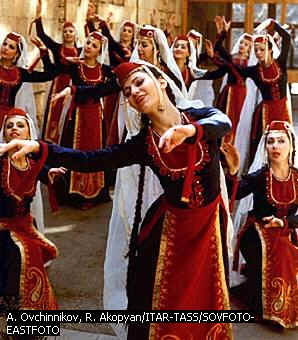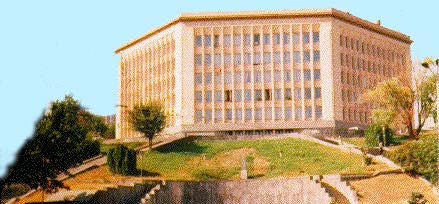II. Population
- Rivers & Lakes
- Climate
- Natural Resources
- Plants & Animals
II. Population
- Agriculture
- Mining
- Manufacturing
- Energy
- Currency & Banking
- Commerce & Trade
- Labour
- Transport
- Communications
- Executive & Legislature
- Political Parties
- Judiciary
- local Government
- Health & Welfare
- Defence
- International Organizations
- Invasion By Foreign Powers
- Independence
The overall population density of Armenia was estimated to be 127 people per sq km (329 per sq mi) in 1997. The urban population is approximately 67 per cent of the total, with the population of Yerevan, the capital city, accounting for more than 50 per cent of the total urban population. Large numbers of Armenians have emigrated; it has been estimated that there are 1.5 million Armenians in the former Soviet republics and 2.5 million in the United States of America. Life expectancy in 1998 was estimated to be 62.4 years for males and 71.2 for females.
For administrative purposes, the Republic is divided into 10 provinces: Aragatsotn; Ararat; Armavir; Gegharkunik; Kotaik; Lori; Shirak; Siunik; Tavush; Vayots Dzor; and the city of Yerevan, which is considered a province.
The largest city is Yerevan, which had an estimated population of 1,254,400 in 1990. The next most populous city, Gyumri (formerly Leninakan, also known as Kumari), is about one tenth the size of Yerevan, with a population of 206,600 in 1990.
The vast majority of the population is Christian. The Armenian Apostolic (Orthodox) Church is the most popular among Armenians. Russian Orthodoxy and Shiite Islam are also practised. The Armenian diaspora numbers some 5 million people, including 1.5 million in the former Soviet Union states, 1 million in the United States, and 400,000 in France.
The official language of Armenia is Armenian, an Indo-European language with a 38-letter alphabet. Russian is also commonly spoken.
Education is obligatory and free of charge at primary and secondary level. The system traditionally reflected Soviet influences in placing great importance on science and technology, but by the mid-1990s greater stress was placed on Armenian culture and history. In 1994-1994 some 590,000 pupils attended primary and secondary schools, 25,200 students attended technical colleges, and there were some 46,500 students enrolled in higher education. Although primary and secondary education is free, higher education is becoming increasingly subject to fees, and by mid-1997, 75 of the 90 institutions of higher education were private. In 1996 expenditure on education amounted to 2.5 per cent of gross domestic product (GDP).
The ancient Kingdom of Van or Urartu was the foundation on which Armenian civilization began in the 6th century BC, and the kingdom was notable for its ornamental glass, ceramics, jewellery, and arms, in particular its production of bronze objects. Armenia’s literary legacy is also ancient, with written literature dating from the 5th century AD, and a tradition of Christianity as a state religion dating from the 4th century AD. Its position between East and West and a role in the development of Indo-Euro languages has ensured a rich literary heritage. St Gregory of Narekatzi (951-1001), renowned author of hymns and mystical poems, is considered to be the first great Armenian poet, and the author of one of the most widely read works in Armenia. Love poetry became common in Armenia, and during the 16th and 18th centuries it was performed by popular bards. One of the greatest exponents of the form was Sayat Nova (d. 1795), who composed his songs of courtly love in Armenian, Azeri, and Georgian. The 19th century saw the dawn of modern Armenian literature, with Khatchatour Abovian (1804-1848) being one of the first authors to adopt modern Armenian for his writing. There are state theatres of opera and ballet, several theatres and orchestras, and a national dance company.
In the early 4th century Armenia became the first country in the world to embrace Christianity as its official religion. Today, more than 90 per cent of the country’s inhabitants are ethnic Armenians, and this ancient form of Christianity manifests itself in many ways. Here, the Song and Dance State Ensemble of Armenia performs at weddings and other festivities.

Armenian
Patriarchate of St. James (Jerusalem)
The Holy Archangels Church is situated
in the southwestern part of the Old City inside the walls of the Armenian
St. James Monastery.
Armenian Alphabet founder
American University of Armenia




